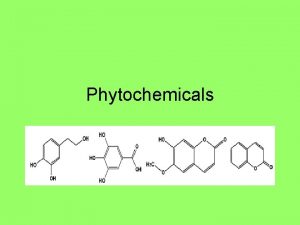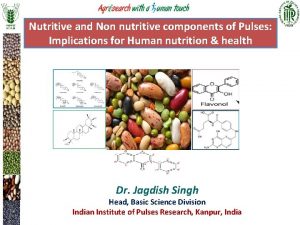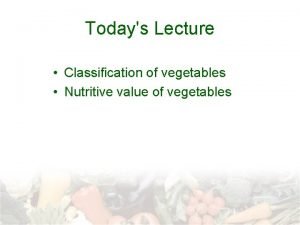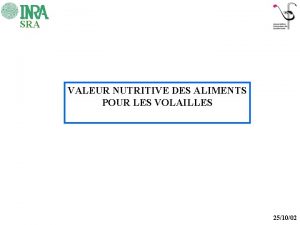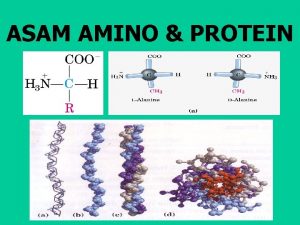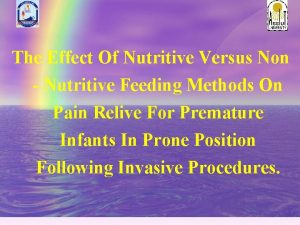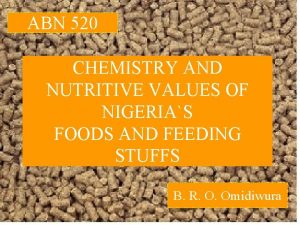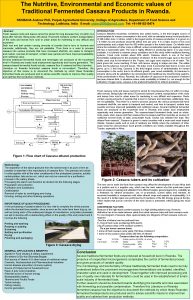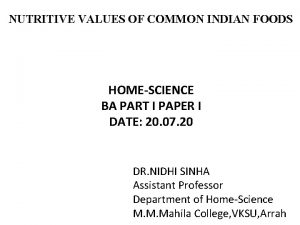UNIT 14 NUTRITIVE VALUES OF PROTEIN AND QUALITY


















![2. Net Protein Utilization [NPU] • NPU is an index that takes into account 2. Net Protein Utilization [NPU] • NPU is an index that takes into account](https://slidetodoc.com/presentation_image/45bc1b3a71174c0966b4443d3af3d71e/image-19.jpg)



- Slides: 22

UNIT 14 NUTRITIVE VALUES OF PROTEIN AND QUALITY ASSESSMENT

14. 1. Nutritive value of protein Food proteins provide amino acids for degradation into carbon skeletons to synthesize glucose for energy and amino acids for the synthesis of other proteins. The diet contains a variety of different animal and plant proteins. The nutritional quality or biological value of a given protein depends upon two factors: (i) its content of essential amino acids and (ii) its digestibility. On the basis of their nutritional quality the proteins has been classified into (1) complete protein and (2) partially complete or incomplete proteins (3) incomplete protein

1. Complete proteins • Complete proteins maintain life and provide for normal growth of the young when used as the only protein in the diet of experimental animals. • Proteins of meat, poultry, fish, eggs and milk are complete proteins and are of high biological value because they contain all essential amino acids. Gelatin is an exception. Some proteins in legumes, cereals and nuts are also complete proteins e. g. glycinin of soybean, glutenin of wheat and glutelin of corn. • Partially complete or incomplete proteins: Partially complete or incomplete proteins maintain life but fail to support normal growth. e. g. gliadin of wheat, hordein of barley.

2. Partially complete or incomplete proteins maintain life but fail to support normal growth e. g. gliadin of wheat, hordein of barley.

3. Incomplete proteins • Incomplete proteins neither maintain life nor support growth. • Most vegetable proteins are incomplete and are of low biological value. (e. g. rice, wheat, corn, beans). • Proteins differ considerably in the relative proportion of amino acids they contain and hence their biological value. • Some proteins contain a complete set of essential amino acids. There are 10 essential amino acids which are need in food in take and the body cannot synthesis them at rates at which they are needed for growth. • The nonessential amino acids are those acids that can be synthesized in the body from a suitable carbon source, amino groups from other amino acids and consequently do not have to be supplied in a ready made form diet

(i) Essential amino acids • Methionine, tryptophan, threonine, valine, isoleucine, phenylalanine, lysine, arginine and histidine and are essential for growth. • Arginine and histidine are not essential for maintenance in adults. • Non-essential amino acids • They are called or dispensable as they can be synthesized in animals from other compounds. • They are glycine, cysteine, alanine, serine, proline, tyrosine, aspartic acid, asparagine, glutamic acid and glutamine. • Cereals contain lower value of lysine while pulses contain lower value of methionine. • Combining plant proteins from different sources ensures a more complete complement of essential amino acids.

(ii) Digestibility • The nutritive value of proteins also depends upon its digestibility. • Animal proteins are the most available for digestion and absorption and the proteins of legumes are the least available because of their incomplete digestibility. • Digestibility depends upon the fiber content present in the food item and also in the remainder portion of diet.

Average Digestibility of some food proteins • Food group Animal foods Cereals Fruits Vegetables Legumes, dried Digestibility coefficient 97 85 85 83 78 Plant proteins, particularly those of wheat and other grains, are not completely hydrolyzed during digestion because the protein-rich portions of the grains are surrounded by protective husks of cellulose and other polysaccharides that are not hydrolyzed by intestinal enzymes. Since only free amino acids can be absorbed from the intestine, not all the amino acids of most plant foods are biologically available.

2. The requirement of proteins and amino acids • Nitrogen equilibrium • When the intake and outgo of nitrogen are approximately same, the individual is said to be in nitrogen equilibrium • The minimum nitrogen intake that will allow the state of nitrogen equilibrium is considered minimum nitrogen (protein) requirement. The nitrogen balance of the body depends on • the physiological state of the individual, • adequacy of energy intake from carbohydrates and fats and • the capacity to adjust to levels of intake.

• Negative nitrogen equilibrium: When the intake and outgo of nitrogen are less the individual is said to be in negative nitrogen equilibrium. • Positive nitrogen equilibrium: When the intake exceeds the outgo of nitrogen are approximately same, the individual is said

RDA for proteins • For an adult (18 -35) about 10 -12% of total calories from proteins in diet are considered adequate. • The requirement for infancy, childhood, during pregnancy and lactation are more. • More proteins are needed under conditions of stress. Increased intake is needed after surgery or injury, wasting illness, or while recovering from extensive burns. • For normal persons the minimum requirement of proteins intake is about 0. 8 g/Kg of body weight for maintenance of nitrogen balance and the recommended daily intake is 1. 0 g/Kg of the body weight.

The FAO reference protein • The protein requirements were reported by a committee for FAO in 1957. • For this a ‘reference protein’ was used which was similar to proteins found in milk, egg and meat. • • The FAO committee has also suggested that the ‘reference protein’ may also be used for appraisal of the protein (amino acid) value of diets and for indicating appropriate methods of supplementing diets deficient in protein (amino acids).

Essential amino acids in reference protein and milk, egg proteins Essential amino acid Amino acids per 100 gm of protein Reference protein Cow’s milk Human milk Egg Isoleucine 4. 2 6. 4 6. 8 Leucine 4. 8 9. 9 8. 9 9. 0 Lysine 4. 2 7. 8 6. 3 Phenylalanine 2. 8 4. 9 4. 6 6. 0 Methionine 2. 2 2. 4 2. 2 3. 1 Threonine 2. 8 4. 6 5. 0 Tryptophan 1. 4 1. 6 1. 7 Valine 4. 2 6. 9 6. 6 7. 4

3. Food sources for the supply of proteins and amino acids • Proteins are widely distributed in nature but only a few foods provide sufficiently higher quantity of proteins. • Eggs, fish, meats, nuts and poultry have protein ranging from 12 -29%. • Cereal contributes 1 -2% of proteins. • Fruits and vegetables are low sources of protein foods. • Syrups, oils and fat contain no protein. • Animal foods have high protein values and also have good quality. • Soya bean and some nuts contain protein of high quality.

4. The supplementary value of protein • Foods differ in the nutritive value of the protein they contain. • Each food, with the exception of gelatin, contains more than one kind of protein, each with a characteristic number and concentration of amino acids. • The proteins of some foods contain limited amount of certain essential amino acids, generous amounts of others. • Therefore a combination of foods in which the amino acid contained in the proteins supplement each other is of higher nutritive quality than either alone. • There are possibilities of combining foods so that amino acids may supplement each other. • For e. g. Lysine is a critical or limiting amino acid of cereals. • Similarly methionine is limited in pulses and is the critical or limiting amino acid of their protein. • They need to be supplemented by animal proteins.

6. Deficiency Diseases of Protein • Protein- energy malnutrition results from inadequate intake of protein and/or calories. Two forms of child malnutrition, often occurring together, are Marasmus and Kwashiorkor. • a. Marasmus: Marasmus (from Greek, “to waste”) is the term applied to chronic deficiency of calories in children. Marasmus is caused by a diet deficient in both protein and calories. (Total calorie deprivation). • Marasmus occurs in famine areas when Infants are weaned from breast milk and given inadequate bottle feedings of these watery gruels of native cereals or other plant foods, usually deficient in both calories and protein. • Marasmus is characterized by arrested growth, extreme muscle wasting, weakness and anemia. • It is usually complicated by multiple deficiencies of vitamins and minerals. • Calorie deficiency in early childhood, even if ultimately alleviated with an ample diet, leaves a permanent deficit in body growth.

b. Kwashiorkor • Chronic protein deficiency in children is called “Kwashiorkor”, an African word that means ‘weaning disease”. • Kwashiorkor is caused by a diet inadequate in protein in the presence of an adequate calorie intake consisting primarily of carbohydrates. • Since the protein content of plant foods is generally low and proteins are also low in quality, a serious shortage of “good” protein often occurs in areas where population growth is especially great. • The growth of protein-deficient children is retarded, they become anemic, and the tissues become watery and bloated because of the low serum protein levels, which upset the normal distribution of water between tissues and the blood. • The liver, Kidneys, and pancreas undergo severe degeneration. There are defects in cellular immunity. • • • -The mortality rate of kwashiorkor -very high. -A permanent physiological deficit. Protein deprivation in early childhood - leaves a deficit in learning and mental ability. ` •

14. 2 Methods for the determination of nutritional quality of proteins • The nutritional quality of proteins can be determines in the following methods • 1. Protein Efficiency Ratio [PER]: This index is not based on nitrogen balances studies. It is, therefore, less precise than BV / NPU, but it is technically easier to derive and use. • PER is defined as the change in body weight relative to the amount of protein eaten. It is usually measured in laboratory rats kept under standardized diet conditions. • Weight gain in grams • PER = ----------------x 100 • Dietary protein in grams • E. g- if a rat is given a standard diet nutritionally adequate in all respects containing 2 g of casein per day as the only source of protein and his weight gain is found to be 5 g per day, then the PER of case in would be 5/2 = 2. 5. Whole egg has a PER of 3. 8, while gelatin has 0 PER.
![2 Net Protein Utilization NPU NPU is an index that takes into account 2. Net Protein Utilization [NPU] • NPU is an index that takes into account](https://slidetodoc.com/presentation_image/45bc1b3a71174c0966b4443d3af3d71e/image-19.jpg)
2. Net Protein Utilization [NPU] • NPU is an index that takes into account the relative digestibility of proteins. • Because even the best mixture of amino acids will be less available for use in the body it is packaged in a protein that is only partially digested. • • NPU = BV x digestibility. N retained Dietary N -[Urinary N + Faecal N] x 100 NPU = ------ x 100 = ------------------------Dietary N • Proteins are generally easy to digest. Most proteins are 90% or more digestible. Thus is most cases, NPU approximates the BV.

3. Chemical Score • • The protein is completely hydrolyzed and its amino acid composition measured and compared with that of egg or milk protein as a standard. This chemical score of a protein indicates the potential value of the protein. amino acid per g of test protein (mg) Chemical Score = ------------------------amino acid per g of reference protein (mg) • Chemical score and biological value • Animal proteins, for example, those of milk, fish, beefsteak, and eggs rank high (>80) in both. • The proteins of rice or wheat have a low chemical score (75) because they are deficient in one or more essential amino acids. However, they also have lower biological value, since they are incompletely digested. Thus a much larger amount of these plant proteins must be consumed to provide the minimum daily requirement of all the amino acids. All the essential amino acids must be available simultaneously for body protein synthesis. • • •

4. Digestibility Coefficient • Nutrients present in the food are not completely available to the human body. • Large portions of the nutrients are excreted in the faeces because of being not digested in the alimentary tract. • Hence, the digestibility of the food is defined as the portion of a food or nutrient which is not recovered in faeces, the portion which has been absorbed by the animal. • Calculation of the digestibility of a whole food is of no use hence it is calculated for each nutrient present in it. • Nutrients eaten (g) – Nutrient in feces x 100 • Digestion Coefficient (DC) = ---------------------- • Nutrient eaten (g) • The digestibility coefficients normally determined are the apparent digestibility coefficients since the nutrients found in the faeces contain small proportion of nutrients from the previously utilized food in the form of mucosal debris, unspent enzymes ate.

5. Pepsin digestibility • Pepsin digestibility assesses the in vitro digestibility of the protein in fluids containing the proteolytic enzyme pepsin. • Ground sample is suspended in 35 ml of a solution of pepsin (1. 5 mg/ml) in 0. 1 M phosphate buffer (p. H 2. 0). • The mixture is then incubated with gentle shaking at 37ºC for 2 hr. • After incubation the suspension is centrifuged (12, 000 x g for 15 min at 40ºC), and the residue is suspended in 10 ml of 0. 1 M phosphate buffer (p. H 2. 0) and centrifuged as before. • The low-pepsin moist residue was freed from the walls of the centrifuge tube with a spatula and dumped in the center of Whatman filter paper no. 3 on a 43 -mm Buchner funnel. • Suction (aspirator) was applied, and the residue in the centrifuge tube washed into the funnel with 5 ml of phosphate buffer (p. H 2. 0). • The filter paper is rolled and inserted in a digestion tube and digested using conc. Sulfuric acid. • The ammonia nitrogen was determined in a Nitrogen analyser. • The percentage of protein digested is estimated.
 Progetto sull alimentazione scuola primaria
Progetto sull alimentazione scuola primaria Calcul valoare energetica alimente
Calcul valoare energetica alimente Nutritive value of egg
Nutritive value of egg Production subsystem
Production subsystem Are phytochemicals non nutritive
Are phytochemicals non nutritive Non nutritive components of diet
Non nutritive components of diet Champignon valeur nutritive
Champignon valeur nutritive Uses of cereals
Uses of cereals Lecture vegetable
Lecture vegetable Au coq valeur nutritive
Au coq valeur nutritive Channel vs carrier proteins
Channel vs carrier proteins Protein-protein docking
Protein-protein docking Machavillian
Machavillian Terminal values and instrumental values
Terminal values and instrumental values Western values vs eastern values
Western values vs eastern values ______ have only two possible values 0 and 1.
______ have only two possible values 0 and 1. Define human value
Define human value Quality assurance vs quality control
Quality assurance vs quality control Basic concepts of quality
Basic concepts of quality Unit 6 review questions
Unit 6 review questions Basic unit of protein
Basic unit of protein Health and social care unit 2
Health and social care unit 2 Quality management pmp
Quality management pmp




